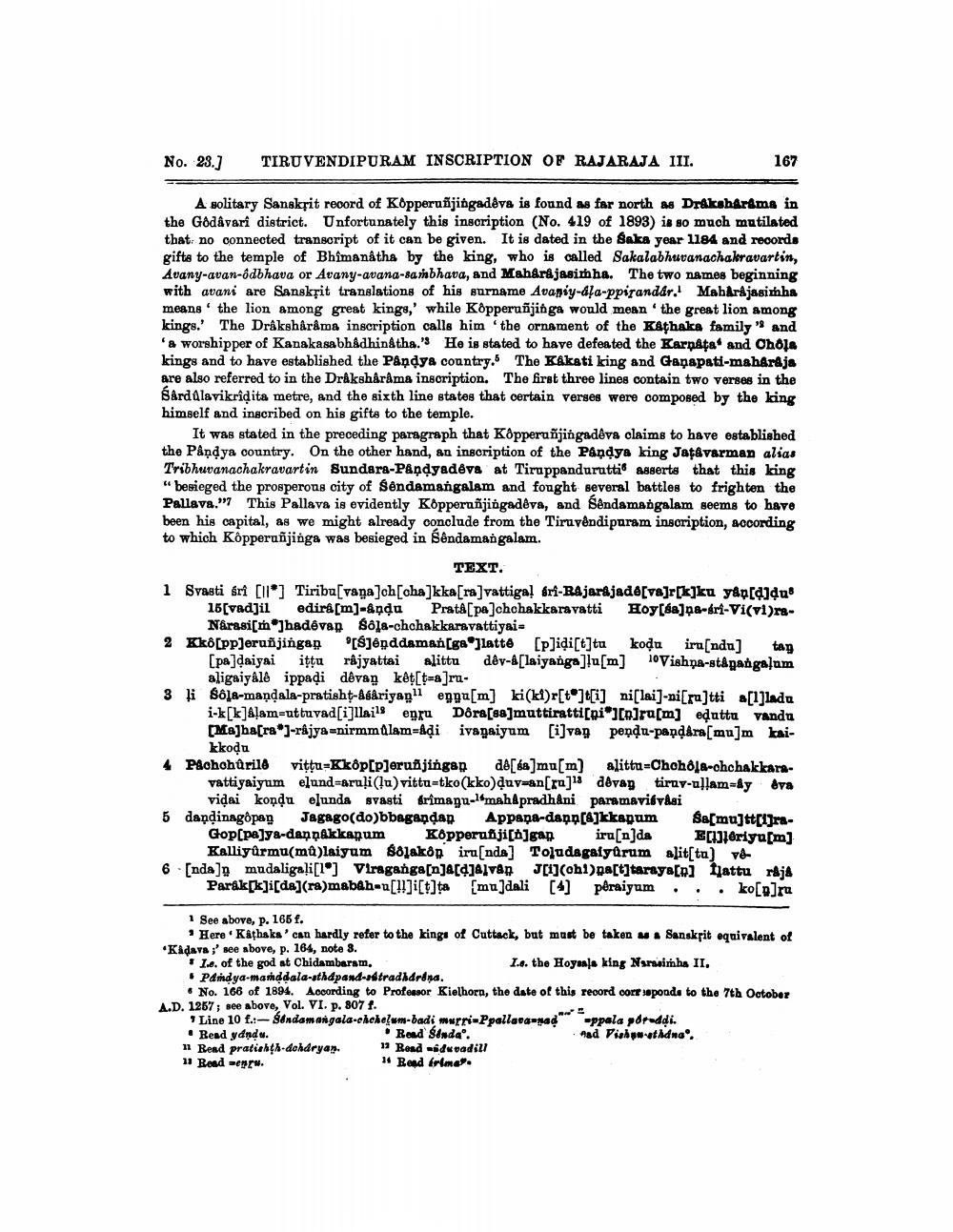________________
No. 23.]
TIRUVENDIPURAM INSCRIPTION OF RAJARAJA III.
4
A solitary Sanskrit record of Kôpperuñjingadeva is found as far north as Draksharama in the Gôdâvarî district. Unfortunately this inscription (No. 419 of 1893) is so much mutilated that no connected transcript of it can be given. It is dated in the Saka year 1184 and records gifts to the temple of Bhimanâtha by the king, who is called Sakalabhuvanachakravartin, Avany-avan-ôdbhava or Avany-avana-sambhava, and Maharajasimha. The two names beginning with avani are Sanskrit translations of his surname Avaniy-dla-ppirandár. Maharajasimha means the lion among great kings,' while Kôpperuñjinga would mean the great lion among kings.' The Drakshârâma inscription calls him 'the ornament of the Kathaka family" and 'a worshipper of Kanakasabhadhinatha." He is stated to have defeated the Karpâța and Chôja kings and to have established the Pandya country. The Kakati king and Ganapati-mahārāja are also referred to in the Drakshârâma inscription. The first three lines contain two verses in the Sardalavikriḍita metre, and the sixth line states that certain verses were composed by the king himself and inscribed on his gifts to the temple.
It was stated in the preceding paragraph that Kôpperañjingadeva claims to have established the Pandya country. On the other hand, an inscription of the Pandya king Jatavarman alias Tribhuvanachakravartin Sundara-Pandyadeva at Tiruppanduratti asserts that this king "besieged the prosperous city of Sendamangalam and fought several battles to frighten the Pallava." This Pallava is evidently Kopperañjingadeva, and Śêndamangalam seems to have been his capital, as we might already conclude from the Tiruvêndipuram inscription, according to which Kopperañjinga was besieged in Sêndamangalam.
TEXT.
167
1 Svasti śrî [*] Tiribu[vana]ch[cha]kka[ra]vattigal éri-Rajarajadė[va]r[k]ku yâp[d]ḍu® 15[vad]il edirâ[m]-âṇḍu Pratâ [pa]chchakkaravatti Narasi[m*]hadevap Soja-chchakkaravattiyai=
Hoy[a]pa-dri-Vi(vi)ra
2 Kkô[pp]eruñjingan [S]ênddaman[ga latte [p]idi[t]tu kodu iru[ndu] [pa]ḍaiyai ittu rajyattai alittu dêv-â[laiyanga]lu[m] 10Vishna-stapangalum aligaiyâle ippadi dêvan kêt[t=a]ru
3 Soja-mandala-pratisht-Adriyag eggu[m] ki(k)r[t][i] nilai-ni[ru] [adu i-k[k]Alam-uttuvad[i]llails enru Dôra[sa]muttiratti[pi][n]ru[m] eduttu vandu [Majha[ra*]-rajya-nirmmalam=âḍi ivanaiyum [i]van pendu-pandara[mu]m kai
kkoḍu
4 Pachchûrile viṭṭu-Kkôp[p]erunjingan dê[a]mu[m] alittu-Chchola-chchakkaravattiyaiyum elund-aruli (lu) vittu-tko (kko)ḍuv-an[ru] dêvan tiruv-ullam-ây va vidai kondu elunda svasti rimagu-mahapradhani paramaviśvási
5 danḍinagopan Jagago(do)bbagandan Appana-dann[a]kkapum
tag
Sa[mu]tt[i]raGop[palya-danṇākkanum Kopperufiji[n]gan iru[n]da E[|]]ériyu[m] Kalliyûrmu(mů)laiyum Solakon iru[nda] Toludagaiyarum alit[tu] vê
6 [nda]n mudaligali[1] Viraganga[n][d]Alvan J[1](chi)pa[t]taraya[n] lattu raja Parak[k]i[da] (ra)mabah-u[!!]i[t]ta [mu]dali [4] pêraiyum .. ko[n]ra
11 Read pratishth-doháryan.
11 Read menru.
1 See above, p. 165 f.
Here' Kathaka' can hardly refer to the kings of Cuttack, but must be taken as a Sanskrit equivalent of 'Kadava;' see above, p. 164, note 3.
I.e. of the god at Chidambaram,
I.e. the Hoysala king Narasimha II.
Pamdya-manddala-sthapand-stradharina.
No. 166 of 1894. According to Professor Kielhorn, the date of this record corresponds to the 7th October A.D. 1257; see above, Vol. VI. p. 807 f.
---
Line 10 f.:- Sendamangala-chchelum-badi murri-Ppallava-nad-ppala pôr-dḍi. ad Fishes-athdna.
• Bead ydndu.
• Read Sinda.
12 Read duvadill
14 Read frima".




